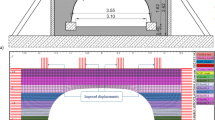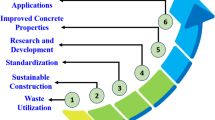Abstract
Biomimetic blades for soil-rototilling and stubble-breaking were designed learning from the geometrical structure of the tips of toes of mole rat (Scaptochirus moschatus). The orientation, the number and the central angle of the biomimetic structure were taken as the testing factors. The optimal structure of the biomimetic blade was determined through the tests of soil-rototilling and stubble-breaking operation in an indoor soil bin. The optimal combination of the biomimetic structure parameters is that three arc concave teeth are equally arranged on the front cutting edge with a central angle of 60°. The results of comparative tests between the optimal biomimetic blade and a conventional universal blade show the torque acting on the biomimetic blade is lower during soil-rototilling and stubble-breaking operations. The results of field tests show that the working quality of the biomimetic blades meets the requirements of the national standard of China. Tests of soil-rototilling show that, when the orientation of the biomimetic structure was at low and middle levels, the torque of biomimetic blades decreased from 34.17 N·m to 31.03 N·m. The torque also decreased with the increase of the number of biomimetic structure. The average torques were 34.57 N°m, 33.44 N°m and 31.37 N°m, respectively. The maximum different value between two levels of central angle was 0.41 N°m. Tests in field indicate that for soil-rototilling operation, the tillage depth is deeper than 80 mm, the soil-crushing rate (length of soil block less than 40 mm) is over 50 %, and the vegetation coverage rate is over 55 %. For stubble-breaking operation, the stubble-breaking depth is deeper than 70 mm, the stubble-breaking rate (length of stubble less than 40 mm) is over 60%, and the stubble coverage rate is over 80%, which can meet the stubble-breaking requirement of corn.
Similar content being viewed by others
References
Tefera B, Ayele G, Atnafe Y, Jabbar M A, Dubale P. Nature and causes of land degradation in the Oromiya region: A review. Socio-Economics and Policy Research Working Paper 36. International Livestock Research Institute (ILRI), Nairobi, Kenya, 2002.
Gao H W, Li W Y. Conservation Tillage Technology and Equipment. Chemical Industry Press, Beijing, China, 2004. (in Chinese)
Larney F G, Bullock M S. Influence of soil wetness at time of tillage and tillage implement on soil properties affecting wind erosion. Soil and Tillage Research, 1994, 29, 83–95.
Temesgen M, Hoogmoed W B, Rockstrom J, Savenije H H G. Conservation tillage implements and systems for smallholder farmers in semi-arid Ethiopia. Soil and Tillage Research, 2009, 104, 185–191.
Jia H, Ma C, Li G, Huang D, Liu Z. Combined rototilling- stubble-breaking-planting machine. Soil and Tillage Research, 2007, 96, 73–82.
Jia H, Ma C, Tong J. Study on universal blade rotor for rototilling and stubble-breaking machine. Soil and Tillage Research, 2007, 94, 201–208.
Jia H, Ji W, Han W, Tan H, Liu Z, Ma C. Optimization experiment of structure parameters of rototilling and stubble breaking universal blade. Transactions of the Chinese Society of Agricultural Machinery, 2009, 40, 45–50. (in Chinese)
Ren L, Tong J, Li J, Chen B. Soil adhesion and biomimetics of soil-engaging component: A review. Journal of Agricultural Engineering Research, 2001, 79, 239–263.
Li J, Ren L, Cui Z, Tong J, Chen B. Experiments on plow mold boards with bionics unsmoothed surface. Proceedings of the 13th International Conference of the ISTVS, Munich, Germany, 1999, 241–248.
Tong J, Moayad B Z, Ma Y, Sun J, Chen D, Jia H, Ren L. Effects of biomimetic surface on designs on furrow opener performance. Journal of Bionic Engineering, 2009, 6, 280–289.
Liu L, Zheng G. General Zoology. Higher Education Press, Beijing, China, 1997. (in Chinese)
Useless animal facts. [2010-8-30], http://www.useless-facts.net/Animals.html.
Ji W, Tong J, Jia H, Chen D, Liu C. Quantitative characteristic features of geometric structures of claws of mole rat. Transactions of the Chinese Society of Agricultural Engineering, 2010, 41, 193–198. (in Chinese)
Ji W, Chen D, Jia H, Tong J. Experimental investigation into digging performance of the claws of mole rat (Scaptochirus moschatus). Journal of Bionic Engineering, 2010, 7, S166-S171.
Scott R G, Richardson R C. Realities of biologically inspired design with a subterranean digging robot example. Proceedings of the 6th IASTED International Conference on Robotics and Applications, Cambridge, USA, 2005, 226–231.
Ji W, Jia H, Tong J, Tan H, Liu Z, Ma C. Analysis of influencing factos on power consumption and field test of universal blade. Transactions of the Chinese Society of Agricultural Machinery, 2010, 41, 35–41. (in Chinese)
Author information
Authors and Affiliations
Corresponding author
Rights and permissions
About this article
Cite this article
Tong, J., Ji, W., Jia, H. et al. Design and tests of biomimetic blades for soil-rototilling and stubble-breaking. J Bionic Eng 12, 495–503 (2015). https://doi.org/10.1016/S1672-6529(14)60140-2
Published:
Issue Date:
DOI: https://doi.org/10.1016/S1672-6529(14)60140-2




